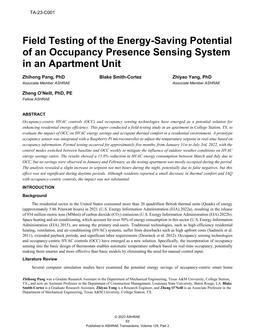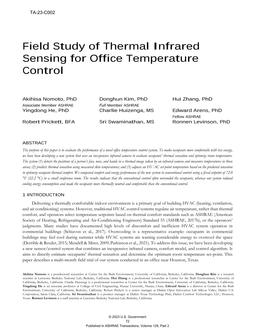-
-
Available Formats
- Options
- Availability
- Priced From ( in USD )
-
Available Formats
-
- Immediate download
-
$16.00Members pay $7.00
- Add to Cart
Customers Who Bought This Also Bought
-

TA-23-C001 – Field Testing of the Energy-Saving Potential...
Priced From $16.00 -

TA-23-C002 – Field Study of Thermal Infrared Sensing for ...
Priced From $16.00 -

TA-23-C012 – Energy and Cost Assessment of The Proposed D...
Priced From $16.00 -

TA-23-C016 – Cooling Energy Savings in Data Centers in Ho...
Priced From $16.00
About This Item
Full Description
Thermal comfort, the perception of satisfaction with the thermal environment, is one of the most debated features of indoor environmental quality. In mechanically ventilated spaces, thermal comfort depends on airflow and temperature. In hot and humid climates, a significant amount of energy is consumed by buildings as the cooling load to maintain thermal comfort. For efficient design, the preference and thermal sensations of the occupants must be better understood, particularly regarding multi-occupancy environments, such as office spaces. Determining temperature setpoints becomes crucial to effectively manage the ventilation system energy consumption by reducing the cooling load while keeping occupants satisfied. In response, experiments were carried out in a controlled environment chamber to study how airflow from a desk fan can offset the temperature setpoints to keep the occupants thermally satisfied. 22 human subjects participated in the experiment; exposed to four different temperature setpoints and three airflow speeds from the desk fan. Their perceived thermal comfort responses were reported on Likert-type scales. Additionally, physiological indicators of thermal discomfort such as heart rate, skin temperature, electrodermal activity, and Blood Volume Pulse were collected during the experiments. The results demonstrated an increase in the temperature set point up to 77°F while augmenting airflow speed of 0.3 m/s on average through the desk fan to maintain comfort, indicating that local devices can compensate for higher temperature setpoints, reducing cooling loads prevalent in hot climate zones. Additionally, statistical analyses performed to establish a correlation between occupant comfort and physiological responses indicates the possibility of predicting discomfort using real-time physiological indicators that leads to occupant-centric intelligent ventilation control.





